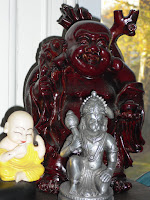I had a great time earlier this spring presenting at the FACES Conference in La Jolla, California. The organizer, Richard Fields, has published a book called
A Year of Living Mindfully: 52 Quotes and Weekly Mindfulness Practices, with contributions from many well-known writers, including Jack Kornfield, Daniel Siegel, Tara Brach...and yours truly. To order the book, you can go to the FACES website: www.FACESCONFERENCES.COM. My essay follows:
Wander into the Center of the Circle of Wonder
When we first being to practice mindfulness, we are taught
to focus on the breath, or on some particular sensory perception, like physical
sensations or sounds. Our
attention naturally wanders, and we patiently and firmly bring our wild primate
minds back to this specific focus.
We do this over and over, and in doing so we train the mind to return to
one point. Our attentional
capacity becomes sharper and clearer, and we find we develop some choice in
what we turn to, and what we turn away from.
But for some of us, at a certain point our practice shifts
from this narrow attentional training to a more spacious awareness. We find that we can sit quietly
in the middle of a shifting array of thoughts, emotions and sensory
perceptions, without much effort.
The Indian teacher Krishnamurti called this practice "choiceless
awareness" and in Zen we call it "shikantaza" or "just
sitting."
The 12th century Chinese Chan (Zen) teacher Hongzhi Zhengjue
encourages us to "wander into the
center of the circle of wonder."
This is his way of describing what "just sitting" feels
like. The mind, which naturally
wanders, can be tamed by the practice of attentional training. But once it has learned to be still, it
is free to do what it loves to do.
Thoughts still occur, emotions pass through the body/mind, sensations
come and go, but we don't get caught in any of this passing experience. We understand that the nature of
the mind is to wander. In this
wandering, everything that is encountered is a teaching, a pointing, to a life
that can be vividly lived. And
every path we wander leads to the same place: "here." The realization of the continual return
to this moment, this time, this place, is liberating. A sense of wonder arises, of not knowing, and deeply
trusting this feeling of simple presence.
Mindfulness Practice
for the Week:
You can use this quote often to remind you to loosen up your
opinions about what you think you're doing, or where you think you're
going. This is a practice that can
be done informally, with regular reminders to yourself throughout the day. Or you can do a formal wandering
practice. Sitting in an upright
posture, allow yourself to be with your breath, your body, and all of your
sense perceptions, thoughts and emotions.
You can notice how all of these experiences come and go, so long as you
don't try to hold on to any one of them.
This is a practice of release from effort, and allows a sense of peace
and not knowing to arise naturally. If you have spent most of your time and
energy training your mind to focus, you may want to give yourself this gift of
wandering. "Wander into the center of the circle of wonder." Enjoy your life.
Melissa Myozen Blacker
Boundless Way Temple
Worcester, MA















